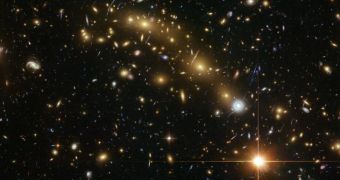Some people in this world are desperate to learn how much one celebrity or another weighs. Astronomers, however, are more passionate about studying the mass of distant celestial bodies, and even galaxies.
By the looks of it, they are also quite gifted when it comes to finding the best way to satisfy their curiosity. What's more, they are more than willing to share their findings with us, ordinary folks.
Not to beat about the bush, recent news concerning space exploration says that astronomers have recently established the mass of a galaxy cluster with an unprecedented degree of accuracy.
The galaxy cluster in question goes by the name of MCS J0416.1-2403. In order to determine its mass, researchers resorted to data and images provided by the NASA/ESA Hubble Space Telescope.
As detailed by Phys Org, the Telescope helped determine that MCS J0416.1-2403's total mass is an astonishing 160 trillion times greater than that of our Sun. This mass is spread across 650-light years that the cluster measures from one end to the other.
Hubble Space Telescope data also made it possible for astronomers to map the galaxy cluster's mass, i.e. make observations concerning not just the total amount, but also distribution.
“It's taken a long time to get telescopes that can make sufficiently deep and sharp observations, and for our models to become sophisticated enough for us to map, in such unprecedented detail, a system as complicated as MCS J0416.1-2403,” says specialist Jean-Paul Kneib.
“Our map is twice as good as any previous models of this cluster!” researcher Mathilde Jauzac goes on to comment on this latest breakthrough in space science.

 14 DAY TRIAL //
14 DAY TRIAL //